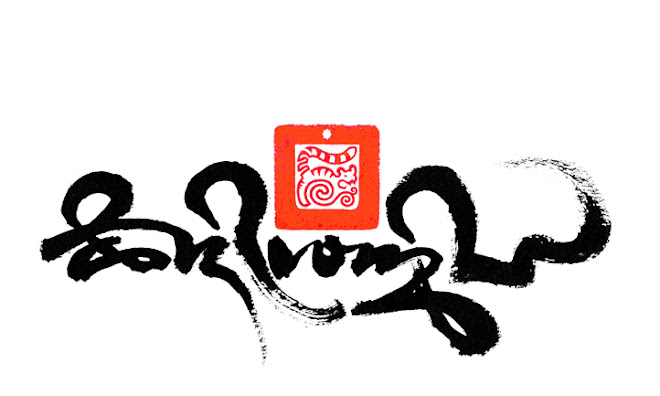 |
'The indivisible unity of means and wisdom'
Chinese ink and mineral paint on Bhutanese tsasho bark fiber paper, soaked in vermilion orange Japanese ink.
35x52cm. ⓒ Tashi Mannox 2022.
35x52cm. ⓒ Tashi Mannox 2022.
The above art piece features a sign; made up of two small circles and a crescent moon shape ༔ is known in Tibetan as a Ter-tseg གཏེར་ཚེག་ When used as a punctuation mark at the end of a line of text or mantra, this tells us that the origin of the mantra or manuscript is a spiritual treasure called a Terma གཏེར་མ་ hidden by Guru Rinpoche or Yeshe Tsogyal for the benefit of future generations.
A Terton is a title given to a spiritually realized person of the Guru Rinpoche linage who has the ability to discover or reveal Terma.
According to the vision of Terton Taksham Nuden Dorje, it is said the two circles symbolize means ཐབས་ and Knowledge/wisdom ཤེས་རབ་ and the crescent moon between them represents their indivisible unity ཟུང་དུ་འཇུག་པ། Although the Ter-tseg as a punctuation mark can also be written as only two ཿ circles without the crescent moon, such as Terma manuscripts from Mindrol Ling.
In the case of a Tibetan manuscript that is not a Terma, the ending of each line of text or mantra is a single vertical stroke called a shad ཤད་ = །
The Ter-tseg sign can also be called namche རྣམ་བཅད་ However, identical in appearance, it plays a different role in Tibetan scriptures. The namche has its origins in Sanskrit as two dots and can usually be found suffixed to singular syllables, such as the Sanskrit syllable hrīḥ ह्रीः Which in the Tibetan phonetics is written ཧྲཱིཿ
In Sanskrit the two small circles called a visarga, has the effect on the root syllable of changing the pronunciation with a light out breath, that has been somewhat lost in the Tibetan pronunciation.
An example of the uses of both Ter-tseg and namche within the Tibetan written language is with the mantra of Guru Rinpoche, as shown below. Two circles are present with the second syllable of the mantra ཨཿ which originates from Sanskrit. The Mantra is then finished with a ter-tseg ༔ announcing that the mantra is of Terma in origin.
ཨོཾ་ཨཿཧཱུྂ་བཛྲ་གུ་རུ་པདྨ་སིདྡྷི་ཧཱུྂ༔
With thanks to the knowledgeable Jayarava for contributing to this short post.

beautiful!!!!
ReplyDeletewhat sort of paper is it on?
is the paper red or painted red?
Dear Tashi, you make my life so much better with your art, I truly, deeply appreciate your work.
ReplyDeleteThank you!
E MA HO!
Thank you so much, learning a lot from this, and the work is simply beautiful!
ReplyDelete